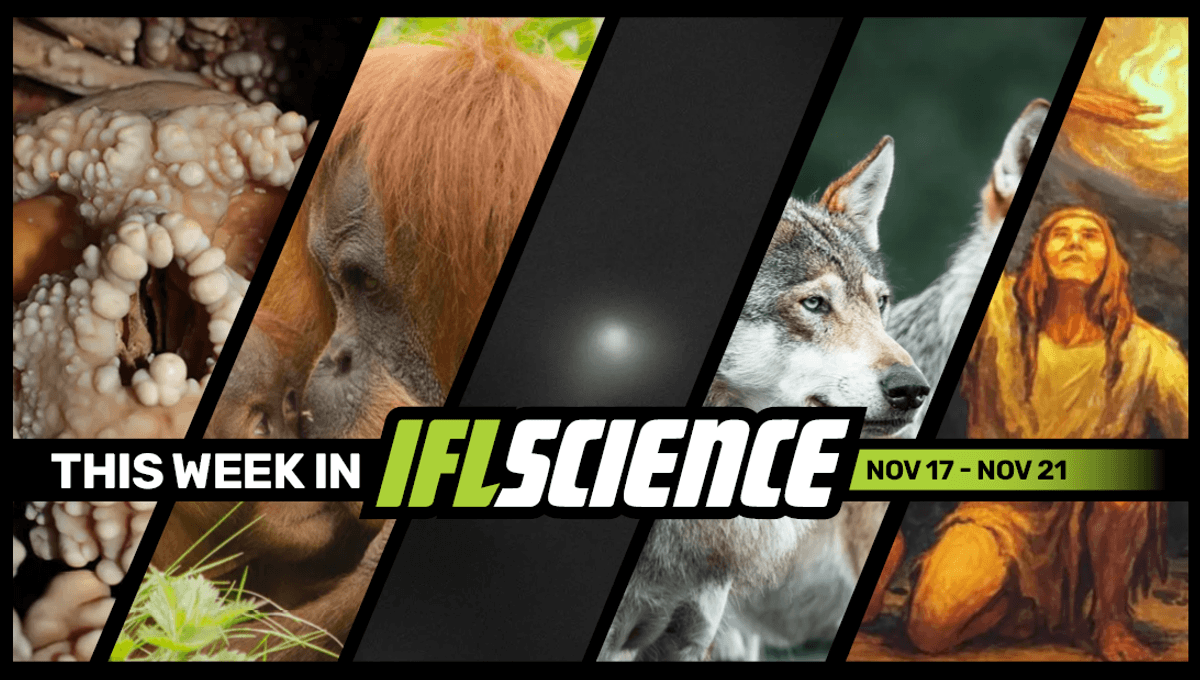
This week, research into the evolutionary origins of kissing has revealed that our ancient ancestors were smooching around 21 million years ago, new footage may be the first evidence of wild wolves using tools, and 14,400-year-old paw prints are the world’s oldest evidence of humans living alongside canine companions. Finally, we share an exclusive clip from Apple TV’s upcoming Prehistoric Planet: Ice Age, and explore how the woolly mammoth was able to “hear” through its feet.
Create an IFLScience account to get all the biggest science news delivered straight to your inbox every Wednesday and Saturday.
First-Ever Look At Neanderthal Nasal Cavity Shatters Expectations
The astonishingly well-preserved nasal cavity of a Neanderthal in Italy has finally settled one of the great debates in palaeoanthropology by completely contradicting our assumptions regarding the facial anatomy of our extinct relative. Previously, scientists thought that Neanderthals possessed specific structures in their noses that helped them deal with cold environments, yet we now know that these features did not actually exist. Read the full story here
Kissing Has Survived The Path Of Evolution For 21 Million Years – Apes And Human Ancestors Were All At It
Evolutionary biologists have been investigating the evolutionarily origins of kissing by taking a broad look at behaviour in Afro-Eurasian primates, a family tree that includes chimps, bonobos, our ancient ancestors, and us, Homo sapiens. They found that lip-touching displays of affection are found in most of the large apes, suggesting it emerged in an extinct ancestor of this group around 21.5 to 16.9 million years ago. In other words, kissing likely evolved around 21 million years ago in our distant primate family, and everyone has been at it since. Read the full story here
NASA Finally Reveals Comet 3I/ATLAS Images From 8 Missions, Including First From Another Planet’s Surface
NASA has finally published several observations of interstellar comet 3I/ATLAS that were taken during the 43-day government shutdown. In a special press conference, the space agency released images from eight different missions that add to the Hubble, JWST, and SPHEREx observations from the summer, as well as those from the NASA-funded ATLAS (Asteroid Terrestrial-impact Last Alert System) telescope, which discovered 3I/ATLAS on July 1. Read the full story here
Incredible Footage May Be First Evidence Wild Wolves Have Figured Out How To Use Tools
Incredible footage from British Columbia shows what may be the first ever instance of tool use by wild wolves. In the recordings, two wolves can be seen pulling on crab trap lines in order to access tasty bait, and while this behavior clearly shows a sophisticated level of cognition, there is some debate over whether it strictly counts as tool use. Read the full story here
14,400-Year-Old Paw Prints Are World’s Oldest Evidence Of Humans Living Alongside Domesticated Dogs
Exploring new caves during the Upper Palaeolithic was fraught with danger, which is why one group of ancient humans in Italy made sure to take their trusted four-legged companion with them when they stepped into the darkness. Analyzing the fossilized foot and paw prints left behind during this subterranean excursion, researchers say that these 14,400-year-old tracks represent the world’s oldest direct evidence of humans living alongside a domesticated dog. Read the full story here
TWIS is published weekly on our Linkedin page, join us there for even more content.
Feature of the week:
How Could Woolly Mammoths Sense When A Storm Was Coming? By Listening With Their Feet
Have you ever noticed how life during the Ice Age just seemed to be much, much bigger? As Apple TV’s new series Prehistoric Planet: Ice Age demonstrates, everything from bears to sloths, birds, and armadillos was far bigger than anything we’ve seen since, but might I point you to one small fact that might’ve escaped your knowledge: woolly mammoths had tiny ears. So, did that mean they had lousy hearing? Not necessarily, as like modern-day elephants, woolly mammoths were able to listen for a kind of sound that’s inaudible to the human ear: infrasound. In this exclusive clip from Apple TV, you can see how. Read the full story here
More content:
Have you seen our e-magazine, CURIOUS? Issue 40, November 2025, is available now. This month, we asked, “How Do We Predict The Weather?” – check it out for exclusive interviews, book excerpts, long reads, and more.
PLUS, the We Have Questions podcast – an audio version of our coveted CURIOUS e-magazine column – continues. In episode 14, we ask, “Can Burying Scientists Alive In The Snow Help Us Protect Polar Bears?”
The Big Questions podcast concludes season 5 with a special bonus episode: Searching For Nessie: IFLScience Takes On Cryptozoology
Source Link: First-Ever Look At Neanderthal Nasal Cavity Shatters Expectations, NASA Reveals Comet 3I/ATLAS Images From 8 Missions, And Much More This Week